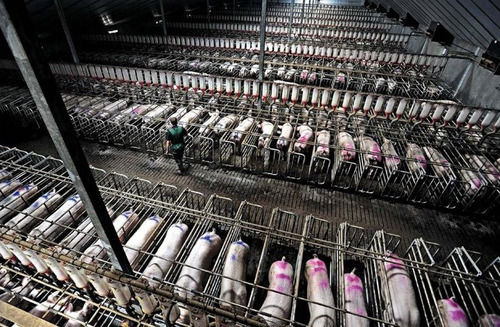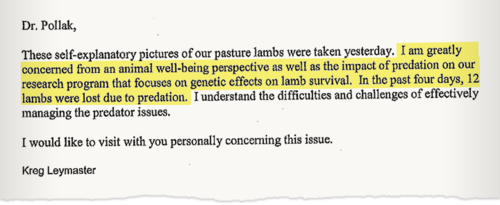Follow-up Report: How to Shut Down a Meat Research Center
In January, an investigative article revealed shockingly inhumane practices allegedly taking place at the US Meat Animal Research Center in Nebraska. Today, the USDA announced that operations there will be examined and overhauled.

New York Times reporter Michael Moss’s deep coverage of a controversial USDA-run animal research center in Nebraska. The article, published in January, lifted the veil on a host of troubling experiments being performed on livestock there. And today, USDA secretary Tom Vilsack announced that no initiatives can begin at the center until procedures there are completely overhauled.
“No new research projects will begin at the US government’s key livestock study center until animal welfare is improved through stronger oversight and better training of standards,” Reuters reports.
Vilsack’s announcement coincides with the release today of a draft of a report on plant conditions conducted by an independent review panel. Investigations began in January shortly after Moss’s piece was published.
Moss’s article, entitled “US Research Lab Lets Livestock Suffer in Quest for Profit,” was a Freedom of Information Act (FOIA)-assisted examination of the operations of the top-secret animal research facility, which occupies 55 square miles in Nebraska. Moss’s reporting, assisted by Times writer Sarah Cohen, found that the lab, founded 50 years ago to develop livestock that “produce more offspring, yield more meat, and cost less to raise,” has experimented on animals at the expense of their safety and welfare.
Among the most startling of his findings had to do with livestock reproduction: pigs, in the facility, are being bred to give birth to up to 14 piglets, as opposed to the normal litter size of eight; but these frail, crowded piglets are often crushed to death by their mothers. Cows, Moss wrote, have been “retooled” to have twins and triplets instead of one calf at a time, and the weak, deformed young that are born die at such high rates that “even meat producers have been repulsed.” And in an effort to develop “easy care” sheep that can survive with minimal human intervention, ewes are giving birth, unassisted, on open fields where newborns face predation, harsh weather conditions, and starvation.
The Times’ reporting “shows that the center’s drive to make livestock bigger, leaner, more prolific, and more profitable can be punishing, creating harmful complications that require more intensive experiments to solve,” Moss wrote.
The article’s publication in January unleashed a firestorm of media coverage, and the USDA quickly announced that it would look into lab conditions.
Meanwhile, lawmakers on both sides of the aisle expressed extreme concern over the article’s findings. During a February 13 budget hearing of the House Appropriations Subcommittee on Agriculture, they urged USDA inspector general Phyllis Fong to seriously assess the newspaper’s troubling statements.
“Your assistance in auditing the claims included in the article and reviewing the current conditions, practices, and policies would be very helpful to us,” subcommittee chairman Robert Alderholt, a Republican from Alabama, said.
“Many of the concerns that were raised in that story about the spending of taxpayer dollars and humane treatment basically border on the bizarre,” Chellie Pingree, a Democratic representative from Maine, said. “They’re completely counter to what the consumer is looking for today. The market is growing in humanely raised, and different levels of treatment for animals, so why taxpayer dollars are being spent on something that’s clearly inappropriate practice raises a lot of questions,” she said.
Subcommittee member Sam Farr, a Democrat from California, pointed out that while it was pricey, his state’s university research facilities had recently overhauled their procedures to be more humane. “I know California has required all the research institutions in the state universities to change all their caging and animal husbandry practices to bring in state-of-the-art humane practices,” he said. “It’s very expensive, but they did it, and I think that’s probably something that we in Congress ought to look at.”
The independent panel that has been reviewing the research center’s operations found “no instances of animal abuse, misuse, or mistreatment,” according to Reuters. But the panel did note a lack of oversight at the facility.

“The center’s Institutional Animal Care and Use Committee provided the review panel no evidence that it met regularly to discuss issues or concerns over animal care,” Reuters reports, “and no evidence of a formal review or approval process for research projects proposed by the oversight committee members themselves.”
Of the controversial practices detailed in Moss’s article, the panel reported, only the pasture-lambing project continued, and those animals were in healthy condition, it said. Secretary Vilsack’s decision to suspend research at the research center is a monumental policy change, but one that doesn’t go far enough for the animal activists at PETA, whose petition to shut down the facility has garnered over 52,670 signatures.
“The US Meat Animal Research Center (MARC) has been using taxpayer dollars for the most extraordinarily crude, cruel, and indefensible experiments in support of a dying meat industry,” PETA president Ingrid E. Newkirk told MUNCHIES in an email. “The death rates shocked even ranchers, and the practices at MARC read like a novel about a mad scientist. It’s time for these experiments to be stopped for good and not just put on hold until public outrage dies down.”
